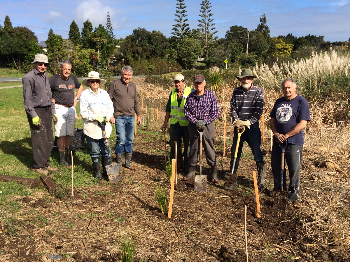
MANGAWHAI'S NO.1 NEWSPAPER
|
|
|
Digging deep for our waterways Mangawhai’s ‘Bridge to Nowhere’ waterway is flowing a bit cleaner and clearer now thanks to the efforts of an enthusiastic group of locals. Mangawhai’s ‘Bridge to Nowhere’ waterway is flowing a bit cleaner and clearer now thanks to the efforts of an enthusiastic group of locals.Mangawhai Riparian Planting Group (MRPG) had a day of planting 200 locally sourced native plants along the corner of Mangawhai-Kaiwaka Road and Tara Road estuary on August 14. Founder and co-ordinator of the MRPG, Jane Vaughan, says the idea is to keep the stream clear and clean via re-planting which encourages fish such as whitebait to spawn in the edges. Currently MRPG has around 20 members with 10-12 being ‘hard-core’ says Vaughan. The groups aim is nothing short of ambitious – to re-plant native vegetation along all streams that flow into the Mangawhai harbour. “Our goal is to plant every little seepage bit, every stream where water is coming out of the surrounding hills around Mangawhai’s boundary,” she says. Vaughan started the environmental group in 2012 after a visit to Raglan where riparian planting began 20 years ago ‘which was unheard of in those days’ she says. “I got so inspired and thought ‘why can’t we do that in Mangawhai? It’s high time the [Mangawhai] estuary was looked after.” MRPG member Alex Flavell holds a Bachelor of Science with a major in Coastal Geography and is just finishing a post graduate in environmental science. He says riparian planting is more than just digging in a few trees. “There are a multitude of benefits in re-vegetating our local streams,” he says. “Including reducing sediment and other pollutants entering the estuary therefore improving water quality, providing habitat for our native fresh water fish, many of which are threatened species and providing a food source.” Increased sediment flow into Mangawhai’s estuaries is also the ‘key driver behind mangrove expansion’. “Mangroves prefer to grow in fine silty sediments and require relatively sheltered areas such as the upper reaches of estuaries to grow,” Flavell says. “For those in the community who want to address mangrove expansion at the cause, then reducing sediment input is the place to start.” Riparian planting also provides ‘fly-ways’, bird migration flight paths, by introducing vegetation for birds to use as links from the coastline to the inner hills. MRPG are funded by a grant from the Mangawhai Endowment Lands Account but like all volunteer groups they need help from people in the community. “It’s a great way to meet new people,” Flavell says. “It’s also a way of learning and teaching others about the environment and helping to leave the special place we call home in a better condition for future generations.” Another planting day will take place at the corner of the Kaiwaka-Mangawhai/Tara Road estuary on Sunday September 11, 9.30am. Bring along a spade, wear suitable clothes and water to drink. Phone Jane Vaughan on 431 5828 if you have any questions “If it is pouring with rain we will make another day but a few showers will not deter us,” Vaughan says. n FACT: Riparian is Latin for riverbank. HARD CORE: Members of Mangawhai Riparian Planting Group making a difference to Mangawhai’s Harbour waters one plant at a time. FILTER: The area of estuary off Tara Rd where the riparian team added around 200 native plants. PHOTO/Alex Flavell
“Our goal is to plant every little seepage bit, every stream where water is coming out of the surrounding hills around Mangawhai’s boundary.” - Jane Vaughan |

 Planting along streams with native vegetation helps to stabilise stream banks, reducing erosion. The below-ground root systems and above-ground foliage and leaf litter, also slow water runoff when it rains. This allows sediment and pollutants such as nitrogen and phosphorous from fertilisers, to settle into the soil and be taken up by the plants, retaining them on land rather than within the estuary.
Planting along streams with native vegetation helps to stabilise stream banks, reducing erosion. The below-ground root systems and above-ground foliage and leaf litter, also slow water runoff when it rains. This allows sediment and pollutants such as nitrogen and phosphorous from fertilisers, to settle into the soil and be taken up by the plants, retaining them on land rather than within the estuary.
